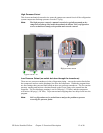
GP Series Portable Chillers Chapter 2: Functional Description 9 of 90
Refrigeration Circuit
Air-, water-, and remote air-cooled refrigerant condensing differ only in the way the
compressed gas is condensed to a liquid. Shown below is a water cooled version.
The refrigerant is compressed in the compressor and
flows through the discharge line as a gas to the
condenser.
There it gives up its heat as it condenses to a liquid
in the condenser.
Liquid refrigerant from the condenser heat
exchanger flowing in the liquid line passes through
a shut-off valve into a filter/dryer that removes
moisture and other contaminants. After the
filter/dryer the refrigerant passes through a solenoid
valve to prevent liquid migration when the
compressor is off. A refrigerant sight glass is
provided to view the flow of liquid refrigerant, and
to view if the system is free of moisture. The
refrigerant then passes through the thermal
expansion valve, which allows the refrigerant to
expand (boil off) and cool (remove the heat from)
the fluid inside of the evaporator.
From the evaporator the refrigerant gas flows
through the suction line back into the compressor.
A modulating electronic hot gas bypass valve is used to control cooling capacity during
intermittent or partial load conditions. This feature contributes substantially to chiller
longevity by eliminating excessive cycling of the compressor and providing close
temperature control.
System Control
Putting this all together, the controller maintains the desired leaving fluid temperature using
multiple inputs to determine if, when and for how long the compressor(s) are on, and if,
when, the percent open and for how long the modeling hot gas bypass valve is on.
Once the unit’s power is enabled and the controller is turned on (see Chapter 4 for more
details on the operation of the controller) it verifies there is sufficient fluid level in the tank (if
present). If there is not enough fluid in the tank the controller will warn the user, or fill the
tank with water from a connected source if equipped with the optional automatic water
makeup valve. See Chapter 3 for more information regarding the initial setup and startup of
the unit.
Once the tank level is satisfied and the start button is pressed, the process pump turns on and
provides flow to the process. The controller verifies the flow through the electronic flow
switch. If the flow is not established within 10 seconds the controller will alarm and disable
the refrigeration circuit. Upon flow verification the controller uses the leaving fluid
temperature and the setpoint temperature to determine the operation of the compressor(s).
When the leaving fluid temperature is greater than the setpoint plus the “compressor on


















